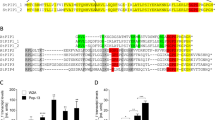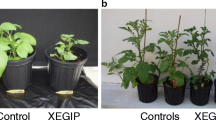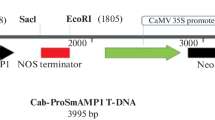Abstract
The defense-related STH-2 gene is rapidly activated following infection or elicitor treatment of potato (Solanum tuberosum L.) tubers. However, its physiological or biochemical function is unknown. To study the STH-2 gene product and its accumulation during the defense response, we raised antibodies to a β-galactosidase-STH-2 fusion protein in Escherichia coli. The antiserum specifically recognized a protein of the predicted 17-kDa size in extracts of elicited tuber disks when analyzed by Western blot. In control extracts this band was not detected. The accumulation of STH-2 protein in response to incompatible and compatible zoospores of Phytophthora infestans (Mont.) de Bary depended on the inoculum density applied. Whereas a low concentration of spores induced accumulation of STH-2 protein faster in the incompatible than the compatible interaction, this difference in timing was less pronounced at higher inoculum densities. Inoculation with a high concentration of compatible spores also resulted in the disappearance of STH-2 protein late during the infection. In both control and induced tuber tissue the antibody strongly reacted with an unknown protein of 18 kDa. This protein was present constitutively in tubers, but in leaves its accumulation was stimulated by inoculation with P. infestans.
Similar content being viewed by others
Abbreviations
- kDa:
-
kilodalton
- SDS-PAGE:
-
sodium dodecyl sulfate-polyacrylamide gel electrophoresis
- STH-2, STH-2:
-
pathogen-activated gene of potato and the corresponding protein, respectively
Referencess
Breiteneder, H., Pettenburger, K., Bito, A., Valenta, R., Kraft, D., Rumpold, H., Scheiner, O., Breitenbach, M. (1989) The gene coding for the major birch pollen allergen Betvl is highly homologous to a pea resistance response gene. EMBO J. 8, 1935–1938
Brisson, N., Giroux, H., Zollinger, M., Camirand, A., Simard, C. (1989) Maturation and subcellular compartmentation of potato starch phosphorylase. Plant Cell. 1, 559–566
Chiang, C.C., Hadwiger, L.A. (1990) Cloning and characterization of a disease resistance response gene in pea inducible by Fusarium solani. Mol. Plant-Microbe Interact. 3, 78–85
Constabel, C.P., Matton, D.P., Brisson, N. (1990) Concurrent synthesis and degradation of alcohol dehydrogenase in elicitortreated and wounded potato tubers. Plant Physiol. 94, 887–891
Ellingboe, A.H. (1981) Changing concepts in host-pathogen genetics. Annu. Rev. Phytopathol. 19, 125–143
Harlow, E., Lane, D. (1988) Antibodies: A laboratory manual. Cold Spring Harbor Laboratory, Cold Spring Harbor, USA
Henderson, S.J., Friend, J. (1979) Increase in PAL and lignin-like compounds as race-specific resistance responses of potato tubers to Phytophthora infestans. Phytopathol. Z. 94, 323–334
Keen, N.T., Yoshikawa, M. (1983) Physiology of disease and the nature of resistance to Phytophthora. In: Phytophthora: Its biology, taxonomy, ecology, and pathology, pp. 279–287, Erwin, D.C., Bartnicki-Garcia, S., Tsao, P.H., eds. APS Press, St. Paul, Minn., USA
Lamb, C.J., Lawton, M.A., Dron, M., Dixon, R.A. (1989) Signals and transduction mechanisms for activation of plant defenses against microbial attack. Cell. 56, 215–224
Marineau, C., Matton, D.P., Brisson, N. (1987) Differential accumulation of potato tuber mRNAs during the hypersensitive response induced by arachidonic acid. Plant Mol. Biol. 9, 335–342
Matton, D.P., Brisson, N. (1989) Cloning, expression, and sequence conservation of pathogenesis-related gene transcripts of potato. Mol. Plant-Microbe Interact. 2, 325–331
Matton, D.P., Bell, B., Brisson, N. (1990) Nucleotide sequence of a pathogenesis-related gene of potato. Plant Mol. Biol. 14, 863–865
Pryor, T. (1987) The origin and structure of fungal disease resistance genes in plants. Trends Genet. 3, 157–161
Rohwer, F., Fritzemeier, K.-H, Scheel, D., Hahlbrock, K. (1987) Biochemical reactions of different tissues of potato (Solanum tuberosum) to zoospores or elicitors from Phytophthora infestans. Planta 170, 556–561
Somssich, I.E., Schmelzer, E., Kawalleck, P., Hahlbrock, K. (1988) Gene structure and in situ transcript localization of pathogenesis-related protein 1 in parsley. Mol. Gen. Genet. 213, 93–98
Stolle, K., Schöber, B. (19) Neue Methode zur Kultur von Phytophthora infestans (Mont.) de Bary in Flüssigmedien. Potato Res. 25, 273–276
Taylor, J.L., Fritzemeier, K.-H., Häuser, I., Kombrink, E., Rohwer, F., Schröder, M., Strittmatter, G., Hahlbrock, K. (1990) Structural analysis and activation by fungal infection of a gene encoding a pathogenesis-related protein in potato. Mol. Plant-Microbe Interact. 3, 72–77
Umaerus, V., Umaerus, M., Erjefält, L., Nilsson, B.A. (1983) Control of Phytophthora by host resistance: problems and progress. In: Phytophthora: Its biology, taxonomy, ecology, and pathology, pp. 315–326, Erwin, D.C., Bartnicki-Garcia, S., Tsao, P.H., eds. APS Press, St. Paul, Minn., USA
Walter, M.H., Liu, J.-W., Grand, C., Lamb, C.J., Hess, D. (1990) Bean pathogenesis-related (PR) proteins deduced from elicitorinduced transcripts are members of a ubiquitous new class of conserved PR proteins including pollen allergens. Mol. Gen. Genet. 222, 353–360
Wardale, D.A. (1980) Lipid-degrading enzymes from potato tubers. Phytochemistry 19, 13–177
Author information
Authors and Affiliations
Additional information
We thank R. Young for the isolate of P. infestans (race 0), G. Banville for certified Kennebec potato tubers, A. Good for the ADH antiserum, D. Riendeau for the 5-lipoxygenase antiserum, and D.P. Matton (Dept. Biochem., Univ. Montréal) for the fusion protein construct. This work was supported by the Natural Sciences and Engineering Research Council of Canada (NSERC).
Rights and permissions
About this article
Cite this article
Constabel, C.P., Brisson, N. The defense-related STH-2 gene product of potato shows race-specific accumulation after inoculation with low concentrations of Phytophthora infestans zoospores. Planta 188, 289–295 (1992). https://doi.org/10.1007/BF00192794
Received:
Accepted:
Issue Date:
DOI: https://doi.org/10.1007/BF00192794




